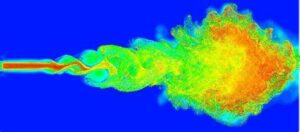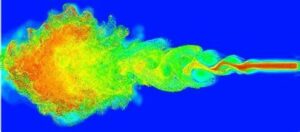As an engineer, now far from my educational roots, I still often think of societal and human dynamics in terms of the models I learned years ago at college. In today’s post I am using a fluid dynamics model to explain what has happened to our society, which will perhaps, offer a clue about how to restore a more peaceful, caring, and flourishing condition to our world. The first figure shows a transition from streamline (or laminar) flow to turbulent. The mode one observes is related to the Reynolds Number, defined as the ratio of inertial force to viscous force. At low Reynolds Numbers, low kinetic/high viscous, the flow looks like the orderly left hand portion. At high Reynolds numbers, it becomes disordered. The actual numerical values depend on the situation, especially the nature of the boundaries of the system, that is, its context. The Reynolds Number at the transition point where the order begins to be disturbed varies with the specific case.

In behavioral terms, kinetic forces can be associated with the routine or habitual actions that characterize normal institutional or embodied, habitual individual patterns. They are driven by the structure of the institutions and the embodied, decontextualized world contained in individuals’ memories. Viscous forces are those that align with behaviors in which the actors are strongly connected to and influenced by the contemporaneous world around them. Remarkably, these two modes also line up with McGilchrist’s divided-brain-model: kinetic forces with left hemisphere and viscous forces with the right. This figure is typical of actual behavior in a pipe as the velocity of the stream is increased. At low flow rates, the mode will be laminar, then going through a transition at some characteristic Reynolds number, and, finally becoming completely disordered at higher rates.
Interestingly, if I flip the figure, it more closely resembles the conditions of present and a potential future behavioral pattern of our own society. The flow at the left end is moving in more or less random or uncoordinated fashion along the horizontal axis which represents historical time. Kinetic forces far outweigh viscous. This portion of the figure seems to be a pretty good representation of our current American society. We are driven by a political economy, made up of institutions conforming to a set of kinetic norms including, among others, growth, efficiency, speed, certainty, and novelty. These norms show up in actions controlled by the left-hemisphere.

Viscous forces, manifest as caring, creative, curious, or spiritual, occur at much lower levels. These forces are the ones that form connections between individuals and the real world that they inhabit. Their low level shows up in the current high degree of psychological stress and pathologies, secularization of religion, environmental damage, and in other places. Viscous forces align with what I have been calling personal wholeness, kinetic with social coherence
The right end, where the disorder largely disappears represents totalitarian or highly authoritarian regimes. Orwell’s 1984 paints a picture much in line with this. A few years ago, I wrote a poem that tells his story.
Orwell’s Vision
Two thousand eighteen minus thirty four
Do the math and get Orwell’s famous book.
A stark vision of what could be in store–
Then, a fright’ning, but unthinkable, outlook.
Today, English (oldspeak) is in danger;
Newspeak, through Fox and tweets, an evil scourge.
What was once true has become a stranger.
Doublethink allows yes and no to merge.
Crimethink has forced the free press to smother.
More blackwhite lies will follow soon, of course.
Bellyfeel raises calls to banish the other,
And soon a camel will become a horse.
It won’t take so long, I say without fail,
For everyone’s home to become a jail.
The viscous and kinetic merge because the actor’s apparent grasp on the world effectively becomes a creation of the authoritarian powers that run the society. Personal wholeness and social coherence dissolve into one another. Behaviors will be largely the same whether arising from the institutional structure or the world stored in the body. These two worlds will have become essentially the same, but no longer resemble what we would cal the real world. Neither of these two regimes, would be a healthy place for human habitation.
The flourishing world I write about would appear to be associated with the transitional portion where the flow is largely streamlined, moving in a coordinated fashion, but allowing for variations driven by individual autonomous behaviors. Otherwise stated, this region represents some healthy balance between kinetic and viscous forces. This is the pattern of sustainability, couched in terms of human flourishing. It may be useful for those who seek such a world to think in terms of a sustainability potential number, akin to the Reynolds number. Continuing the engineering analogy, I will call the number, Sfl. Academic researchers could find the proper terms to use to define the two opposing forces and, perhaps, find a range of values that characterize historical conditions.
The second picture, as noted, seems to portray the conditions in many of today’s modern, industrialized societies. We/they are highly disordered with little coherence in the historical flow. We have existed for a long time in the disordered mode, becoming evermore polarized over time. Institutions continue to become more powerful as money and other forms of power have become very unevenly and inequitably distributed. The viscous forces that maintain some order arising out of personal autonomy have been lessening, and, it would seem, creating the possibility that we will shift into the right-hand, totalitarian or authoritarian mode, bypassing an extended period of flourishing. The challenge to those who would seek to establish the flourishing mode for such an extended time is to stop this shift from happening and move instead to a balance between the two forces such that flourishing can emerge.
The divided-brain-model may help those who are working to reduce the present disorder without overshooting and being pulled into the authoritarian mode. The primary route suggested by this model is to increase the power of the right-brain hemisphere, a shift that would increase behaviors that reflect being connected to the “real” real world, not the false one created by authoritarians. In my previous work, I have called for deliberately engaging in right-hemispheric directed activities, like artistic exercises. suggestion counter to the present effort to emphasize STEM courses in education.
Current “science-based” methods used in the social sciences to shape policies and strategies should give way to pragmatic frameworks, which rely on the right, not the left, hemisphere and provide a truer picture of the immediate world than do those mimicking the natural sciences. End the efforts to remove the past and certain portions of the present from libraries and educational materials. These efforts to remove evidence of the past diminish our sense of the real world, and narrow the possibility of connecting with it. I will not expand here further as an expanded discussion can be found in my book, The Right Way to Flourish: Reconnecting with the Real World.
In any case, I hope that this analogy between the historical flow of societies and fluid flow mechanics is helpful in pointing to the dangers of our present balance between the power institutions have over us and our individual capacity to connect to the world and act in ways that fit whatever we discover by connecting with it. The United States, with a few serious departures, has, while still distant from flourishing, kept the disorder under control better than most other nations and has avoided the stultifying totalitarianism that maintains a false sense of order that is far, far from the balance necessary of both the kinetic and viscous on which flourishing depends.
Ortega would relate to this. Meditations in technology